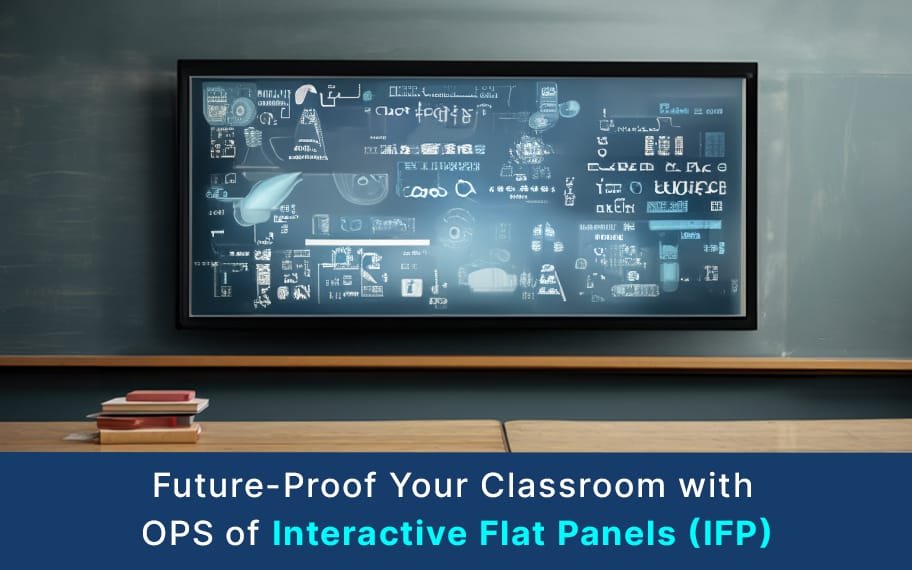
Future-Proof Your Classroom with OPS for Interactive Flat Panels
Description
Present world education has been revolutionized by some advanced teaching tools. They are fast, convenient and modern, enough to keep students and teachers engaged in an upgraded classroom.
What is OPS without an FPS? An interactive flat panel display (IFPD) is one such device that makes educational goals successful through visual content – images, texts, anything students can derive more productivity from. However truly make future-proof classrooms we need something more, like the open pluggable specification technology.
What is OPS?
OPS or Open Pluggable Specification Technology was first introduced in 2010 by NEC, Intel, and Microsoft to add computing capabilities in an FPD (Flat Panel Display). It is budget-friendly and economical for educational institutions to have an OPS for Interactive panels since it makes replacing computing modules easier and reduces electronic signage downtime.
The best part about using OPS for flat panel displays is the flexibility it allows teachers while planning their classroom teaching methodologies. They can think more about improving the learning experience of students since it replaces costly hardware and the time required to look up reliable educational resources. For example, you can imagine how effective a teacher can become if they already have every teaching material ready in hand which can be displayed to the entire classroom allowing the students to interact with every lesson plan. Being completely customizable, teachers spend more time organizing elaborate teaching plans through this latest technology since the classroom setup time has now been significantly reduced.
OPS for interactive panel is the best format available in computing modules. It supports interfaces:
- HDMI/DVI
- UART
- Audio
- Power
- USB 3.0/2.0
- DisplayPort
What are the benefits of OPS?
Making a future-proof classroom with OPS for interactive flat panels has its own set of benefits:
Classroom management
Relying on technology devices is essential for classrooms in modern times. Similarly, educational institutions must have solutions ready at hand in case there is a need for software updates or to fix security patches system configurations, and so on. With an OPS, they can expect to manage all updates with a little help from IT administrators to keep all classroom technology updated regularly.
Improved Student Teacher experience
How can we expect students to learn from a classroom which is not interactive? The answer is, we can’t. And how can we expect teachers to completely use the customizable and technologically advanced options without knowing what is OPS? The answer to that also is, they can't.
Once teachers realize how they can use it to improve classroom productivity by maintaining an organized appearance and eliminating all the clutter, they can create a visually exciting learning environment for all students. A computing module that is directly integrated as OPS for interactive panels minimizes a teacher's requirement to use external devices. Simply put, if we remove all the tangled cables and improve the quality, resolution and convenience of learning visually, students can focus much better. They engage freely and automatically retain information well. Since losing focus is a common problem that the present generation faces because of the vast amount of media consumption, teachers can expect students to be attentive with OPS-integrated FPD.
Functional Classroom
OPS allows integration in quite a few range of devices and software applications. Educational institutions have to worry less about the compatibility of their flat panel displays and OPS. It truly makes a classroom functional by enabling the use of digital contact and access to resources with ease.
Flexible and Upgraded
A traditional classroom although effective never had such technological advancements. It was not every day that students enjoyed the great range of digital content and interactive activities. hence it was not as flexible. If teachers had to share some personal experience they would have to bring cameras printed photographs, or physical resources from libraries.
With an Open Pluggable Specification, they can connect additional devices like cameras and other software easily to support their teaching styles.
Technical Simplification
It is easy for educational institutions to spend a chunk of their budget on updates technical advancements and other upgrades to digital classrooms. But removing and inserting OPS modules is one of the simplest installation processes out there. Teachers don’t have to be an expert to use it, they can upgrade or replace the module any time they want. It encourages the use of Flat Panel Displays. It’s completely secure too with hardware-level encryption.
OPS technology’s standardized approach makes classrooms Future-Proof. It is a solution for everyone - the students, teachers, and the educational system in general.
Conclusion
In conclusion, embracing OPS (Open Pluggable Specification) for interactive flat panels is essential for educators looking to future-proof their classrooms. By adopting this standardized technology, teachers can seamlessly integrate various educational tools and applications, ensuring versatility and longevity in their instructional methods. OPS facilitates effortless upgrades and compatibility with evolving technologies, empowering educators to stay ahead in the ever-changing landscape of education.
With its flexibility, scalability, and ease of use, OPS transforms traditional classrooms into dynamic, interactive learning environments, enriching the educational experience for both teachers and students alike. Embracing OPS is not just about keeping up with the times; it's about leading the way towards a more engaging, collaborative, and effective learning journey for generations to come.
Short Description
What is OPS without an FPS? An interactive flat panel display (IFPD) is one such device that makes educational goals successful through visual content – images, texts, anything students can derive more productivity from. However truly make future-proof classrooms we need something more, like the open pluggable specification technology.